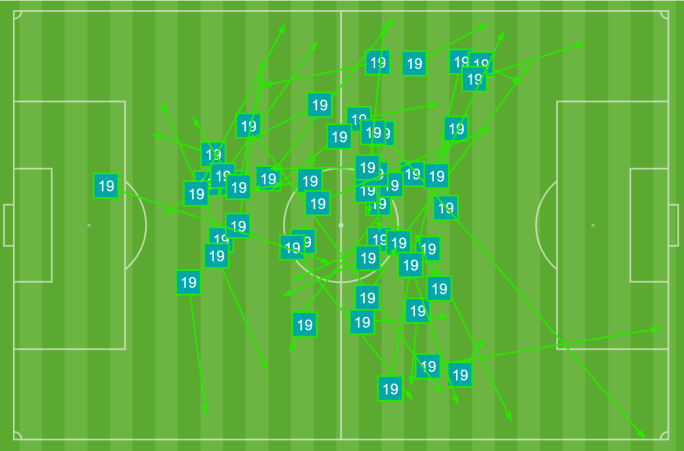
If you’ve been following the work on this site from the very start (dating all the way back to May, 2016), you’ll know that TheMastermindSite.com started with humble beginnings based around player ratings and player evaluations – in the form of Team of the Week’s and Top 100 Footballers lists, which we still occasionally do from time to time. I have always been fascinated with the idea of using both statistics and the eye test of the onlooker to evaluate players, rather than simply one or the other. The problem with doing so centers around the difficultly of quantifying off-the-ball actions and events. It’s why sites like FotMob and WhoScored? rely solely on statistical evidence for evaluating players. But, as I’ve discussed over and over, what a player does on a football pitch from a pure on-the-ball event perspective, quantifies only a small percentage of their actual role or influence on a match. What a player does off the ball can often be the key to a good performance, allowing a player to enhance their on-the-ball metrics in the process. So this begs the question – how can you evaluate a player’s performance if they weren’t really all that involved in the action, but stuck to their specific role perfectly?
Embed from Getty ImagesTake Conor Gallagher for example, who rarely touches the ball in any given match. His role is much more about hard off-the-ball work, where his on the ball stats will then spike in glimpses when he needs to be involved – such as in Palace’s high-block, defensive transitions, or crosses into the box. A player like Gallagher may still achieve a high player rating for winning his 1v1 duels or spikes in specific statistics like tackles or shots; but that doesn’t fully capture the overall influence he may have had in helping his team win a football match. We have to steal again from John Muller’s brilliant ‘no-touch all-stars’ article, and discuss another Conor – Conor Coady – who rarely makes tackles like a defender would be expected to do, but is so crucial to organizing Wolves’ defensive structures. If Coady even makes one tackle and does so successfully, that in itself should boost his rating more significantly than it would, because that’s not his role in the team.
Embed from Getty ImagesEssentially, a player’s role in the team, which can be quantified from the continued perpetuation of a range of both on and off-the-ball events over time, is what we should be evaluating players based on – rather than just pure statistics. A striker should not be expected to make a high number of clearances out of the box, and a defender should not be expected to create a high number of chances in the final third. While you may have outliers, that is generally not the role of either player. Take another example of a centre-back who completes a low percentage of his passes, but is being asked to continuously hit long passes into the channels for strikers to chase. The centre-back’s low passing percentage may not be a direct result of their own lack of passing quality, but how teammates receive those passes, time their runs into space, or challenge for aerial duels. Instead of lambasting the long passer for being wasteful in possession, the coach may praise the player for performing their specific role in the team to a high level, particularly if they accurately select moments to be progressive with finding teammates long, as opposed to playing short and simple.
Embed from Getty ImagesWhen evaluating players and assigning ratings, we first must assess a player’s specific role in the team, and how they fit into the over-arching ideologies and structures set in place. This, of course, requires the evaluator to make inferences on what a player’s role might be in a match. But the beauty in this, is that it can then take into account both on-the-ball and off-the-ball metrics. For example, a defensive midfielder’s job in front of the back-line may be to win back possession, but it’s also generally to screen passes into the striker and anchor the midfield line in front of the back four. How well they perform that role cannot necessarily be quantified through on-the-ball metrics. You could say for example that the opposition’s number nine received only a few passes over the course of the match, and use that as justification for their ability to screen. But perhaps the role of the opposition’s number nine wasn’t to receive progressive passes, but to instead stretch the back-line, get on the end of set-pieces, and press from the front. Perhaps that striker never even operated in central channels throughout the course of the match.
So what is the point in me telling you all of this? Well, the Canadian Premier League is back. And, as a result of not being the most high-profile of leagues around, a player rating site like WhoScored? does not have data scientists on the case. I have endeavored to make up for that gap in potential knowledge by creating my own rating system – which is based around what I’m calling ‘role continuity’ – how well a player performs their role, based on what their coach is asking them to do over time. Similar to xG, the evaluation system will take into account what has become expected of a player in a specific position, AND a specific role over time, and then continuously update the scoring system based on a range of on-the-ball and off-the-ball actions a player in that specific role performs over time.

Scores will be assigned using statistics to assess how well they accomplished their role. As an illustration, completing 9/9 progressive passes is generally a good metric for assessing a player’s progressive passing. But the ‘eye test’ will also be used to assess those harder to quantify metrics, such as a player’s positional understanding, split second decision making, and movement off the ball. Further, how simple or complex were those progressive passes? How well did they move into space to receive the ball before their progressive passes? The eye test can take all of these more difficult to measure items into account.
Inherently, it’s a more ‘biased’ system, but it aims to capture more than just statistics like so many other player rating systems. The potential value in this method of assessing players outweighs the ‘bias’ that can come into play – aiming to elucidate a clearer picture of what a player actually accomplished over the course of a match. As a slightly more experimental league still finding their footing on the global stage, the Canadian Premier League is the perfect place to test out these theories and our player evaluation model.

At present moment, I’ve segmented a variety of different player roles within each of the normal positional classifications. A player could be defined as more than one role, but I endeavour to generally limit each player to a maximum of two ‘roles’ that they adopt, allowing ease of access for evaluation. By assigning roles, the aim is to identify metrics that may be more important for one player in a specific position than another in that exact same position.
Embed from Getty ImagesFor example, we may expect a ‘Sweeper Keeper‘ to get involved in build-up and make more defensive actions outside the penalty area, than we would of a ‘Shot Stopper’, allowing us to continue to praise the Sweeper Keeper for successfully completing those tasks, without criticizing the Shot Stopper. In the same manner, we wouldn’t criticize the Sweeper Keeper for not participating in any events outside the penalty area in a specific match, if they were told to hold a more reserved position, or were not called upon to enact pressure outside the box. Instead, we would continue to evaluate based on what is generally expected of not only the role they performed in the match, perhaps that of a ‘Shot Stopper’, but also their ‘position’ (i.e. claiming crosses, making saves, releasing pressure, etc.). Doing so helps us to continue analyzing a player based around important statistics, without over-amplifying unimportant metrics. Here are the twenty-two unique player roles that I have established at this present moment…
GOALKEEPERS
FULLBACKS
CENTRE BACKS
DEFENSIVE MIDFIELDERS
CENTRAL MIDFIELDERS
ATTACKING MIDFIELDERS
WINGERS
CENTRE FORWARDS
Within each position, we can use these roles to assess what a player in a specific position would normally be required to do, and how well the player performed those tasks in any given match. But we can also dig deeper into the exact job description of a specific role, and put a greater emphasis and weight on those specific tasks and functions instead of less important ones. For example, we would assess a ‘Target’s aerial connections and hold-up play differently from a false nine, despite both players operating in the same quote unquote “position”.
As the Canadian Premier League season progresses, I’m positive that these player roles may adapt. For example, it’s very possible that all ‘Anchors’ tasked with holding the midfield and screening the defense are also ‘Deep-Lying Playmakers’, and that the two roles can be combined together. It may also become clear that all CPL ‘Targets’ are frequently asked to run the channels. As a result, I make no attempt to categorize players into the vast variety of Italian terminologies that I may have missed. Instead, I present these thirty-two roles with the aim of identifying an over-arching role for each player, based on a combination of traits and a variety of skillsets. I could have divided for example ‘Ball-Playing Centre-Halves’ into ‘Long Passing Specialists’ and ‘Ball Carriers’, but that would likely become too specific, rather than encapsulating the broad range of skills that player may offer. Take Tomas Soucek at West Ham United for instance, who is an exceptional aerial threat. But his role in the team (believe it or not) is much more about the defensive side of the game, shuffling and ‘shuttling’ with the play – which is why we would quantify him as a ‘Shuttler’.
Embed from Getty ImagesWithin each role players are given a score in each sub-category, based on a mixture of on-the-ball and off-the-ball metrics. The details of this exact approach are still being refined, and remain quite complicated to divulge at this present moment, but be sure to stay tuned for an article where I’ll detail the exact process in the next few weeks.
By all means, this system is not perfect, and inherently more biased than a purely statistical approach – particularly if I stand alone as the individual evaluator of off-the-ball metrics. As a result, I would love to hear your feedback, comments, questions or anything that you think we’ve missed, or that you could contribute to the mix.
Thanks for reading, and see you soon!
What does all this mean? Be sure to check out our follow-up articles, including a detailed description of each of the roles found below!
More from this series…
-> Explaining the Shot Stopper – Player Role Analysis
-> Explaining the Sweeper Keeper – Player Role Analysis
-> Explaining the Wide Warrior – Player Role Analysis
-> Explaining the Inverted Fullback – Player Role Analysis
-> Explaining the Wing-Back – Player Role Analysis
-> Explaining the Ball-Playing-Centre-Half – Player Role Analysis
-> Explaining the Stopper – Player Role Analysis
-> Explaining the Sweeper – Player Role Analysis
-> Explaining the Anchor – Player Role Analysis
-> Explaining the Midfield Destroyer – Player Role Analysis
-> Explaining the Deep-Lying Playmaker – Player Role Analysis
-> Explaining the Shuttler – Player Role Analysis
-> Explaining the Box to Box Midfielder – Player Role Analysis
-> Explaining the Tempo Setter – Player Role Analysis
-> Explaining the Midfield Maestro – Player Role Analysis
-> Explaining the Creative Ten – Player Role Analysis
-> Explaining the Inverted Winger – Player Role Analysis
-> Explaining the Dynamic Dribbler – Player Role Analysis
-> Explaining the Direct Goal-Scorer – Player Role Analysis
-> Explaining the Channel Runner – Player Role Analysis
-> Explaining the Creative Link – Player Role Analysis
-> Explaining the Target – Player Role Analysis
YOU MIGHT ALSO ENJOY…
Why Jesse Marsch is perfect for the Canadian Men’s National Team
The American coach made his name across an incredibly successful spell at RB Salzburg between 2019-2021, but hasn’t been able to hold down the fort since. His brief stints at RB Leipzig and Leeds United showed signs of promise, but also many moments of doubt. So with Marsch being out of a top-tier job for…
Pep Guardiola – Manchester City – Tactical Analysis (2023-24)
This might finally be the year. It might finally be the year that Pep Guardiola and Manchester City don’t win the Premier League. Despite that, they’ve still been the most tactically complex team in the league, carrying on from much of the tactics that brought them a treble-winning triumph last season. Here is what Pep…
Game of Numbers #38 – Alejandro Garnacho’s intensity & awareness
It’s amazing to think that Alejandro Garnacho is only 19 years of age. Sometimes, you can see the rawness in his game. The facets that still need to be carefully developed. But as he ages, let’s hope he never loses his tenacity. His hunger for more. His appetite to win at all costs, even when…





73 thoughts on “Evaluating players based on role continuity”